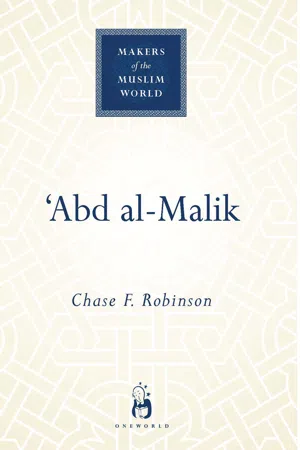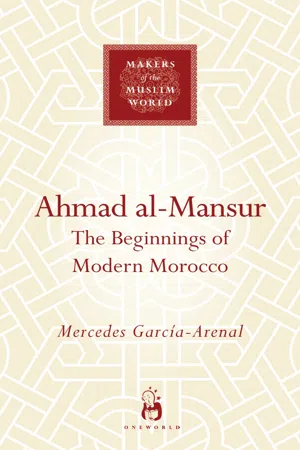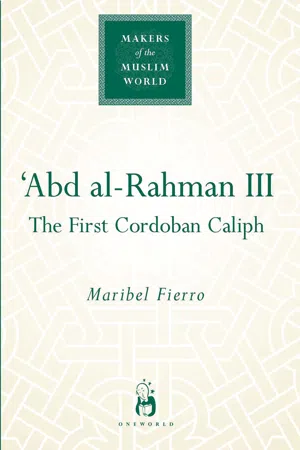History
Abd al-Malik
Abd al-Malik was the fifth Umayyad caliph who ruled from 685 to 705 AD. He is known for centralizing the administration of the Islamic empire, standardizing coinage, and constructing the Dome of the Rock in Jerusalem. Abd al-Malik's reign marked a significant shift in the governance and cultural identity of the Islamic world.
Written by Perlego with AI-assistance
Related key terms
8 Key excerpts on "Abd al-Malik"
- eBook - ePub
- Chase Robinson(Author)
- 2012(Publication Date)
- Oneworld Publications(Publisher)
Was this the case? Al-Hajjaj’s pronouncement is striking because most Muslims from the ninth and tenth centuries would come to reject circumambulation around all buildings except the Ka‘ba (and explicitly proscribe it around the Prophet’s grave), just as they would reject circumambulation of individuals. It is true that the report may have been put into circulation by an opponent of the Marwanids, with a view to attaching opprobrium to both governor and caliph. Of opponents they certainly had plenty. According to a history written by a North African sectarian, ‘Abd al-Malik is a tyrant and al-Hajjaj accursed, and a fifteenth-century historian from Egypt catalogues the manifold vices of the Umayyads, including al-Hajjaj’s view, expounded from none other than a mosque pulpit, that ‘Abd al-Malik was superior to the Prophet. Both also take the Marwanids to task for changing the time of prayer. It is unlikely, however, that our circumambulation account can be dismissed on the grounds of such hostility, for a polemicist would have had al-Hajjaj dissuade the faithful from discharging a widely accepted and revered practice – circling the Ka‘ba – rather than an aberrant one, such as circling the Prophet’s house. We should accordingly follow the principle introduced above, according to which discordant reports have a special claim on our trust, especially if they fit a broader pattern. And this one does fit a broader pattern. According to a letter written to ‘Abd al-Malik and credited to al-Hajjaj, God held the caliph in higher regard than He did the Prophet Muhammad himself.It is through the rains summoned by the caliph that the community is nurtured, as it is in the shade he throws that it finds shelter. When ‘Abd al-Malik makes his case against Ibn al-Zubayr, he makes a case for himself as “God’s shadow on earth” (al-Baladhuri, 33). And it is by one’s imam that believers knew correct belief and praxis. As the poet, al-Farazdaq, put it, “You are to this religion like the direction of prayer, by which people are guided from going astray” (Kister, ‘Social and religious concepts’, 106). We have already seen that Farazdaq describes the caliph as God’s instrument who guides His flock.What ‘Abd al-Malik and other Umayyad caliphs promised to deliver to those who recognized and embraced them as imams (religious leaders) was nothing less than salvation. “He who dies having no religious leader will die the death of a pre-Islamic pagan,” as an early tradition puts it (such a death lands one in Hell). It is precisely because the stakes were so high that the controversies and battles of the Second Civil War were so fierce. “What do you witness for Ibn Zubayr?”, a commander asked of the people of the province of Jordan: “We bear witness that Ibn al-Zubayr is a hypocrite [a term used for those who deny Islam] and those of the people of Harrah (the site of a battle) who were killed are in Hell.” The commander himself held that “if the religion of Yazid b. Mu‘awiya was truth while he was alive at that time, it is still so today and his party [shi‘a - eBook - ePub
The First Dynasty of Islam
The Umayyad Caliphate AD 661-750
- G. R Hawting(Author)
- 2002(Publication Date)
- Routledge(Publisher)
Chapter 5 ‘Abd al-Malik and al-HajjajAfter Marwan’s accession to the caliphate in 684 all of the remainder of the Umayyad caliphs were descended directly from him. It is remarkable that his son ‘Abd al-Malik (caliph 685–705) was himself succeeded in the caliphate by no fewer than four of his own sons, the succession of the brothers continuing down until 743 and being interrupted only by the brief caliphate of their cousin ‘Umar b. ‘Abd al-‘Aziz (717–20).1 ‘Abd al-Malik’s immediate successor was his eldest son al-Walid I (705–15) and his rule seems hardly differentiated from that of his father, for, almost from the time when the civil war ended until shortly before the death of al-Walid, the dominant figure in the sources is the governor of Iraq and viceroy of the east al-Hajjaj (governor 694–714). Like his predecessor Ziyad, we tend to hear more about him than about the caliphs in Syria and he thus serves to give a unity to the period of ‘Abd al-Malik and al-Walid. This period, although not without its problems for the government, was in some ways the high point of Umayyad power, witnessing significant territorial advances both in the east and the west and the emergence of a more marked Arabic and Islamic character in the state’s public face. Before discussing the period following the civil war, however, there are some developments in the earlier part of ‘Abd al-Malik’s caliphate which need to be noted.First, the grip of the Marwanids on the caliphate was tightened. At the meeting which discussed the future of the caliphate before Marj Rahit in 684 the Marwanids had not been the only branch of the Umayyad family in contention, and acceptance of Marwan seems to have been secured only at the price of guarantees regarding the future right of succession of some of the other contenders. The claims of the surviving members of the family of Yazid b. Mu‘awiya may have been sidestepped by Marwan’s marriage to Yazid’s widow Fakhita. Indeed some sources say that Marwan’s refusal to honour the promises he had made about the succession of Khalid the son of Yazid led Fakhita to poison her new husband. A stronger rival of Marwan was ‘Amr b. Sa‘id al-Ashdaq of another branch of the Umayyad family, whose seniority was indicated by the fact that he had been governor of Medina for a while under Yazid. When ‘Abd al-Malik succeeded Marwan, ‘Amr felt that the guarantees made before Marj Rahit had not been honoured, and, in 689–90, taking advantage of the absence of ‘Abd al-Malik in the field against the Zubayrids, he revolted and seized Damascus. ‘Abd al-Malik had to abandon his expedition and on his return to Damascus he had ‘Amr b. Sa‘id killed, apparently after promising him a safe conduct.2 - eBook - ePub
Ahmad al-Mansur
The Beginnings of Modern Morocco
- Mercedes García-Arenal(Author)
- 2012(Publication Date)
- Oneworld Publications(Publisher)
Abd al-Malik AND AHMAD BEFORE THE BATTLE OF ALCAZARM ost of what can be understood about Muley Ahmad al-Mansur’s life before his accession to the throne must be deduced from what is known of the life of his brother, Abd al-Malik, with whom he shared almost twenty years of exile. Abd al-Malik was a brilliant man who attracted a great deal of attention among his contemporaries, and ample documentation concerning him has survived. He laid the foundations for the administrative reforms and improvements in diplomatic relations that would be continued by his brother Ahmad. Above all, Abd al-Malik undertook a complete restructuring of the armed forces with regard to instruction, organization and recruitment. Brief though it was, Abd al-Malik’s reign undoubtedly shaped the nation that his brother inherited.Abd al-Malik, the second son of Muhammad al-Shaykh (the first sultan of the Sa‘dian dynasty), was born in 1541. When his brother Abdallah assumed the throne in 1557, he fled first to Tlemcen and then to Algiers and Istanbul, together with his brothers Abd al-Mu’min and Ahmad. Ahmad, born in 1549, was eight years younger than Abd al-Malik. It is not clear that Ahmad always accompanied his older brother, but we do know that Abd al-Mu’min stayed in Tlemcen, where he was given a post by the Turks and where, years later, he was assassinated by henchmen sent by his brother Abdallah. The fact that Abd al-Mu’min was the only brother disposed of in this way may indicate that he was the only one in Tlemcen at this moment. However, it is clear that Ahmad spent a considerable number of years in Tlemcen. In fact, although little is known about Muley Ahmad’s first marriage, his eldest and favourite son, Muley Muhammad al-Shaykh al-Ma’mun, was born in Tlemcen and was educated at the city’s madrasa - eBook - ePub
- Andrew Marsham, Andrew Marsham(Authors)
- 2020(Publication Date)
- Routledge(Publisher)
While the biographical dictionaries and other sources provide us with an abundance of details concerning the early history of Malikism in al-Andalus, we are still at a loss when it comes to determining its many crucial aspects. It is very difficult to name the exact period when this school first becomes dominant in al-Andalus (as we have seen, the main theories in scholarship differ in this regard) or why it achieved this peculiar of dominance. It can be said that the aforementioned ‘revolt of the suburbs’ represents a major turning point (we are ill-informed as to why the revolt broke out or what in particular caused the Maliki jurists to act as its leaders) – the policy of al-Hakam’s son and successor, ʿAbd al-Rahman II (d. 852), will be very different. During his reign Maliki scholars (perhaps most importantly, ʿAbd al-Malik b. Habib) made their way to the highest offices and their influence seemingly rose in comparison to the reigns of ʿAbd al-Rahman’s predecessors. 86 At the same time, the example of Ibn al-Qutiyya shows the extent to which the accounts of jurists and jurisprudence can be ideologically biased, which further complicates our task of ‘reconstructing’ the relationship between the Umayyads and the Malikis. The early history of Maliki law does not appear, so far, to be a major theme in the research on the Umayyad ideology of power. It is hoped that the present chapter may contribute to broadening our knowledge of these questions and showing, if only partially, the importance of jurisprudence in the historiographical image of the Cordoban Umayyads. Notes 1 The two first modern syntheses of history of al-Andalus treat this period extensively, entire volumes being dedicated to it. Dozy 1861: III and Lévi-Provençal 1956: II and III (the second volume deals with political history of the caliphate, while the third contains a survey of the Andalusian culture in this period). 2 Martinez-Gros 1992. 3 Martinez-Gros 1997. 4 Cf - eBook - ePub
Muslim Spain and Portugal
A Political History of al-Andalus
- Hugh Kennedy(Author)
- 2014(Publication Date)
- Routledge(Publisher)
'Abd al-Raḥmān set out to replace the old-style leaders with his own supporters. The clearest example of this comes from the junds of Egypt and Hims settled in Beja and Seville. It seems that 'Abd al-Raḥmān had appointed the Umayyad 'Abd al-Malik b. 'Umar b. Marwān as governor of Seville and the west and that this was resented by local leaders who felt that this was an encroachment on their power. Al-'Alā had attracted widespread support in the area and 'Abd al-Raḥmān is said to have been worried that the soldiers from Seville in his own army would desert to the rebel cause. 7 In 766 one Sa'īd al-Maṭari rebelled in Niebla and took over Seville before being killed by the Amir. In the same year he had another leader from the area, Abū'l-Ṣabbāḥ Yaḥyā al-Yaḥṣubī, executed in Cordoba. The dead man's followers sought revenge and the people of Seville joined his cousins in an attempt to take Cordoba by surprise. It was not until 774 that the rebellion was finally defeated by 'Abd al-Malik b. 'Umar. This seems to have completed the defeat of the jundi leaders in this area and their subjection to effective control from Cordoba. 8 Another ideological challenge came from an 'Alid pretender. In the eastern Islamic world, the members of the house of 'Alī, first cousin to the Prophet and husband of his daughter Fāṭima, were the most powerful focus of opposition to both Umayyad and 'Abbasid caliphates. Most of their following, however, came from Iraq and points east and they had little support among the Syrians who formed the majority of the Arab settlers in al-Andalus. Heterodox religious opinions were more widespread among the Berbers, however. In North Africa at this time, these opinions usually took the form of Kharijism, but in 768 and 770 a Berber of the tribe of Miknāsa called Shaqyā b - eBook - ePub
The Meaning of Mecca
The Politi of Pilgrimage in Early Islam
- M E McMillan(Author)
- 2012(Publication Date)
- Saqi Books(Publisher)
‘Abd al-‘Azīz was an Umayyad (albeit one distant from the centre of power) 113 and as such, his governorship and leadership of the pilgrimage continued to keep the Holy City and the ḥajj free from the toxin of tribal politics. ‘Abd al-‘Azīz was useful to the caliph in another way: his leadership of the ḥajj in 98/717 acted as a counterweight to Abū Bakr’s in 96/715. If members of the ruling family had been concerned by Sulaymān’s decision to appoint an outsider like Abū Bakr to lead the ritual, then ‘Abd al-‘Azīz’s leadership of it in 98/717 would have gone some way to reassure them. Thus, Sulaymān’s brief caliphate saw him adopt a ḥajj policy which, at times, echoed those of his Umayyad predecessors but, at other times, turned Umayyad practices on their head. Whether he would have continued to innovate is simply impossible to know given the brevity of his caliphate. One of the acts for which Sulaymān is most remembered came right at the end of his caliphate. Unsure who to nominate as his successor, he left it until he was on his deathbed to decide the next caliph. With the help of his advisor, Rajā’ b. Ḥaywah, he altered the succession, taking the caliphate away from the Banū ‘Abd al-Malik and giving it to his cousin ‘Umar b. ‘Abd al-‘Azīz. 114 ‘Umar had received the oath of allegiance on Sulaymān’s behalf when he became caliph; he had been with him in Medina during his ḥajj, and he would lead the prayers over his bier. ‘Umar, like Sulaymān, had opposed some of al-Walīd’s policies and, like Sulaymān, he had given refuge to those fleeing the severity of al-Ḥajjāj’s governorship in the east. That opposition had cost him his job as governor of Medina for al-Walīd but in Ṣafar 99/September 717, it may have helped him assume the highest position of all. 1 EI 2 nd edition, s.v. Walīd b. ‘Abd al-Malik. 2 EI 2 nd edition, s.v. Sulaymān b - eBook - ePub
Abd Al-Rahman III
The First Cordoban Caliph
- Maribel Fierro(Author)
- 2012(Publication Date)
- Oneworld Publications(Publisher)
THE COLLAPSE OF UMAYYAD POWER AND ITS RECOVERY BY ‘ABD AL-RAHMAN III (912–28)MUSLIMS AGAINST MUSLIMS: THE UMAYYAD CONFRONTATION WITH ARABS, BERBERS, AND MUWALLADSI shall speak about the battle-days of the best of men; one who has been adorned with generosity and courage; One who has destroyed unbelief and rebellion and sundered sedition and schism. For we were experiencing a moment of darkness intense as the night, as well as a civil war; being like the scum and rubbish [swept] by the torrent, Until that worshipper of the Clement who is the most eminent of the Banu Marwan was invested with power. Being supported [by God] he appointed a sword from the edges of which death flowed, to judge over his enemies. While he saluted royal power at dawn along with the new moon, so that they both arose in the morning like two rivals in beauty. Ibn ‘Abd Rabbihi (transl. J. T. Monroe)The Umayyad ‘Abd al-Rahman II (r. 822–52) had promoted in al-Andalus the ‘Abbasid way of doing things. This policy had its mundane aspect in court life, which was thoroughly transformed by the Iraqi musician Ziryab, who entered al-Andalus in 822 and under the patronage of the Umayyad emir introduced many innovations in music, food, clothing, hair styles, and etiquette. The royal production of official robes and textiles (tiraz ) was established. At the same time, a scholarly class of jurists and scholars started to emerge in the Umayyad capital, Cordoba, and in other towns. The degree to which a growing central administration penetrated the different districts of al-Andalus is seen in the increasing information offered by the sources about the emir’s nomination of military commanders, governors, tax collectors, and judges. Centralizing policies were continued by the Umayyad emirs Muhammad (r. 852–86) and al-Mundhir (r. 886–8).As the Umayyads struggled to consolidate and expand their grip on al-Andalus, opposition to them, described by the sources as rebellion, exploded from time to time. The tensions between local elites and central government were endemic in the frontier regions. There, the Umayyads often limited themselves to acknowledging the existing autonomy of local rulers by granting them official nomination in exchange for recognition and the payment of taxes. In other regions of al-Andalus, local Arab and Berber groups also defied Umayyad officials and their policies. A new situation arose when Muwallads or leaders belonging to the local population appeared. As indicated in the previous chapter, muwallad - eBook - ePub
The Prophet and the Age of the Caliphates
The Islamic Near East from the Sixth to the Eleventh Century
- Hugh Kennedy(Author)
- 2022(Publication Date)
- Routledge(Publisher)
5 The early ‘Abbasid caliphate DOI: 10.4324/9780429348129-5 The coming of the ‘Abbasid caliphate: 132–145/750–763 The Umayyad caliphate was overthrown by a movement in favour of rule by the Family of the Prophet, Āl Muḥammad. In the nine decades since the death of ‘Alī, it had become accepted by many discontented Muslims that the problems of the community would never be solved until the lead was taken by a member of the Holy Family. An imām or mahdī from the Family would be able to interpret the Qur’ān and Sunna and would have the necessary divine guidance to put right the injustices of Umayyad rule and end the violent disputes between Muslims. A more detailed plan of reform was not necessary; the accession of the just ruler and government according to the Qur’ān and Sunna would solve all problems. During this period, however, it was not entirely clear who was included within the Family of the Prophet or how the leader would be chosen from among the many men who could claim this relationship. In later centuries, the Family of the Prophet was taken to be the descendants of ‘Alī and Fāṭima, and both Twelver and Isma‘īlī Shī‘īs alike accepted that the progeny of al-Ḥusayn b. ‘Alī were the true imāms. In Umayyad times, however, this was much less clear-cut and the boundaries of the Family more vague. At the time of Muhktār’s revolt, the imām from the Family of the Prophet was to be Muḥammad b. al-Ḥanafiyya, a son of ‘Alī but not of Fāṭima, showing that direct descent from the Prophet was not considered essential. In the last decade of Umayyad rule, there was a large-scale rebellion, supported by many different opposition groups in Iraq and western Iran, in the name of ‘Abd Allāh b. Mu‘āwiya, a descendant of ‘Alī’s brother Ja‘far. It was therefore with some justice that the ‘Abbasid family, descendants of the Prophet’s paternal uncle al-‘Abbās, could claim to be members of the Family
Learn about this page
Index pages curate the most relevant extracts from our library of academic textbooks. They’ve been created using an in-house natural language model (NLM), each adding context and meaning to key research topics.







